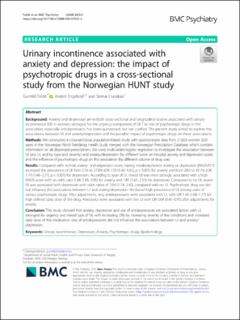| dc.description.abstract | Background
Anxiety and depression are in both cross-sectional and longitudinal studies associated with urinary incontinence (UI) in women, strongest for the urgency component of UI. The role of psychotropic drugs in this association, especially antidepressants, has been questioned, but not clarified. The present study aimed to explore the associations between UI and anxiety/depression and the possible impact of psychotropic drugs on these associations.
Methods
We conducted a cross-sectional, population-based study with questionnaire data from 21,803 women ≥20 years in the Norwegian Nord-Trøndelag Health Study merged with the Norwegian Prescription Database, which contains information on all dispensed prescriptions. We used multivariate logistic regression to investigate the association between UI (any UI, and by type and severity) and anxiety/depression (by different score on Hospital anxiety and depression scale), and the influence of psychotropic drugs on this association (by different volume of drug use).
Results
Compared with normal anxiety- and depression score, having moderate/severe anxiety or depression (HADS≥11) increased the prevalence of UI from 27.6 to 37.8% (OR 1.59 (1.40–1.81), p < 0.001) for anxiety and from 28.0 to 43.7% (OR 1.79 (1.46–2.21), p < 0.001) for depression. According to type of UI, mixed UI was most strongly associated with a high HADS-score with an odds ratio 1.84 (1.65–2.05) for anxiety and 1.85 (1.61–2.13) for depression. Compared to no UI, severe UI was associated with depression with odds ratios of 2.04 (1.74–2.40), compared with no UI. Psychotropic drug use did not influence the associations between UI and anxiety/depression. We found high prevalence of UI among users of various psychotropic drugs. After adjustments, only antidepressants were associated with UI, with OR 1.36 (1.08–1.71) for high defined daily dose of the drug. Anxiolytics were associated with less UI with OR 0.64 (0.45–0.91) after adjustments for anxiety.
Conclusion
This study showed that anxiety, depression and use of antidepressants are associated factors with UI, strongest for urgency and mixed type of UI, with increasing ORs by increasing severity of the conditions and increased daily dose of the medication. Use of antidepressants did not influence the associations between UI and anxiety/depression. | en_US |

